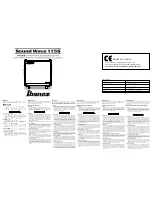
These amplifiers are designed to work within a 10 to 16 volt DC range. Before any wires are connected, the
vehicles electrical system should be checked for correct voltage supply with the help of a voltmeter.
First, check the voltage at the battery with the ignition in the OFF position. The voltmeter should read no
less than 12V. If your vehicles electrical system is not up to these specifications, we recommend having it
checked by an auto electrician before any further installation. Once the vehicle is checked, make certain the
correct cable gauge is used. We recommend using as large a gauge cable as possible, use the Power Cable
Selection Chart to calculate the correct power wire size for your application.
POWER
This amplifier should be wired directly to the vehicle battery using the appropriate size cable. Start at the
vehicle battery and run the power cable through to the amplifier. Avoid running the power cable over engine
components and near heater cores. The use of an inline fuse or circuit breaker is a must; this will prevent
the risk of a potential fire caused by a short in your power cable. Connect the fuse holder or circuit breaker
as close to the battery positive (+) terminal as possible (no farther then 18” from the battery). This fuse or
circuit breaker should be no greater then the sum of the fuses found on the chassis of your amplifier (also
see specifications chart). You may now connect the cable to the battery, but remember to leave the fuse out
or circuit breaker “off” until all other cable connections are made.
Fig.3 Power Input Connection
MONO
SPEAKER
CH1
FUSE
BATT
+
REMOTE
GND
CH2
FUSE HOLDER
Battery
Near
Battery
Remote Turn ON
To Power Antenna
Chassis
Ground
(–)
9
Содержание ASA 1100.5x
Страница 22: ......










































